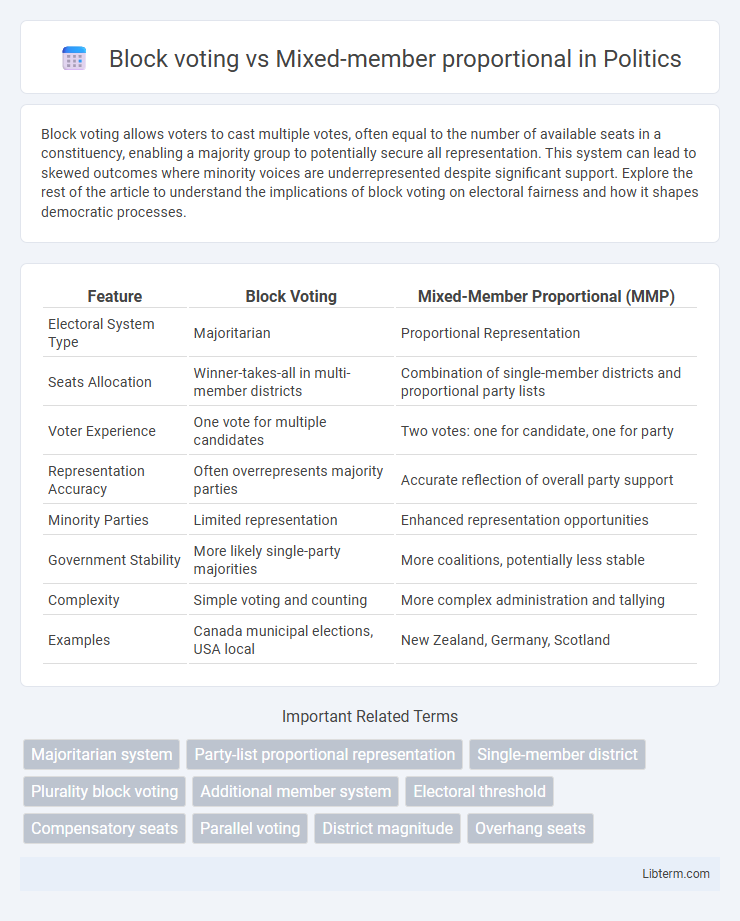Block voting allows voters to cast multiple votes, often equal to the number of available seats in a constituency, enabling a majority group to potentially secure all representation. This system can lead to skewed outcomes where minority voices are underrepresented despite significant support. Explore the rest of the article to understand the implications of block voting on electoral fairness and how it shapes democratic processes.
Table of Comparison
| Feature | Block Voting | Mixed-Member Proportional (MMP) |
|---|---|---|
| Electoral System Type | Majoritarian | Proportional Representation |
| Seats Allocation | Winner-takes-all in multi-member districts | Combination of single-member districts and proportional party lists |
| Voter Experience | One vote for multiple candidates | Two votes: one for candidate, one for party |
| Representation Accuracy | Often overrepresents majority parties | Accurate reflection of overall party support |
| Minority Parties | Limited representation | Enhanced representation opportunities |
| Government Stability | More likely single-party majorities | More coalitions, potentially less stable |
| Complexity | Simple voting and counting | More complex administration and tallying |
| Examples | Canada municipal elections, USA local | New Zealand, Germany, Scotland |
Introduction to Block Voting and Mixed-Member Proportional
Block voting is an electoral system where voters cast multiple votes for candidates in multi-member districts, often resulting in the dominant party winning all seats. Mixed-member proportional (MMP) combines first-past-the-post district representatives with party list seats, ensuring overall proportional representation in the legislature. MMP balances local constituency accountability with proportional fairness, contrasting the majoritarian nature of block voting.
How Block Voting Works
Block voting works by allowing voters to cast as many votes as there are seats available in a constituency, often leading to the dominant party winning all the seats. This winner-takes-all system tends to amplify majorities and reduce representation for smaller parties. In contrast, mixed-member proportional systems combine direct district winners with party-list seats to ensure overall proportional representation.
Mechanics of Mixed-Member Proportional Systems
Mixed-member proportional (MMP) systems combine first-past-the-post single-member district elections with party-list proportional representation to balance local representation and overall proportionality. Voters typically cast two votes: one for a candidate in their constituency and another for a political party, with party seats allocated to compensate for disproportionality in district results. This dual-vote mechanism ensures that the final composition of the legislature reflects the total party support across the electorate, reducing discrepancies common in block voting systems.
Key Differences Between Block Voting and MMP
Block voting allows voters to cast multiple votes for candidates in a single-member or multi-member district, often resulting in a winner-takes-all outcome that favors larger parties. Mixed-member proportional (MMP) voting combines single-member district elections with a proportional representation system to balance constituency representation and overall party proportionality. Key differences include block voting's tendency to produce disproportional results and MMP's ability to better reflect the overall vote percentage through compensatory party list seats.
Advantages of Block Voting
Block voting simplifies the electoral process by allowing voters to select multiple candidates in multi-member districts, which can lead to clearer majorities and stable governments. This system strengthens party discipline and accountability by concentrating power within cohesive party blocs, making it easier for elected representatives to implement policies. Voters benefit from its straightforward mechanism, reducing confusion and encouraging higher participation rates compared to more complex proportional systems.
Advantages of Mixed-Member Proportional
Mixed-Member Proportional (MMP) voting ensures a more accurate representation of political parties in the legislature by combining direct district elections with proportional party lists, reducing wasted votes. This system enhances voter choice by allowing individuals to vote separately for a preferred candidate and a party, promoting both local accountability and proportional fairness. MMP minimizes disproportionate outcomes common in block voting, fostering diverse and inclusive governance reflective of the electorate's overall preferences.
Disadvantages and Criticisms of Block Voting
Block voting often results in disproportional representation, enabling dominant parties to secure all or most seats despite minority support. This system can marginalize smaller parties and reduce electoral competitiveness, leading to less diverse legislative bodies. Critics argue that block voting undermines fair representation and voter equality, contrasting with mixed-member proportional systems that aim to balance constituency and proportional seats.
Challenges with Mixed-Member Proportional Systems
Mixed-member proportional (MMP) systems face challenges such as complexity in voter understanding, which can lead to ballot errors or misinterpretation of dual votes. The need to balance overall proportionality with local representation sometimes causes overhang seats, complicating parliamentary size and coalition negotiations. Tactical voting and party list manipulation also pose risks to true proportional outcomes, undermining the intended fairness of MMP.
Case Studies: Countries Using Block Voting and MMP
Block voting is employed in countries like the United States for local elections and India in certain state assemblies, where it often results in a dominance of major parties and limited representation for minorities. Mixed-member proportional (MMP) systems, used by New Zealand and Germany, combine constituency-based and party-list seats to enhance proportional representation and reduce wasted votes. Case studies show MMP tends to produce more balanced legislatures with higher voter satisfaction compared to block voting systems, which can lead to disproportional outcomes and less diverse governance.
Conclusion: Which System Promotes Fairer Representation?
Mixed-member proportional (MMP) systems promote fairer representation by combining district-level accountability with proportional allocation of seats based on overall party vote share, ensuring minority voices gain parliamentary presence. Block voting often leads to disproportional results, favoring dominant parties and marginalizing smaller groups. The proportional component of MMP corrects the distortions typical of block voting, enhancing inclusivity and reflecting voter preferences more accurately.
Block voting Infographic

 libterm.com
libterm.com